
Star/Syllabus Cup/Championship Regolamento - Rules
Regolamento (ITA)
Clicca su i titoli per espandere gli argomenti
1. Competizioni
1.1. Syllabus Cup - Le Syllabus Cup sono Concorsi riservati alle Coppie “Syllabus” ovvero i primi livelli di competizioni per principianti, con programmi di gara che contemplano esclusivamente figurazioni di base.
1.2. Star Cup - Le Star Cup sono concorsi aperti a tutte le coppie, dai principianti fino alla Classe Internazionale e Professionisti. La Senior Cup fa parte del circuito Star Cup ed è un appuntamento riservato solamente ai competitori Senior
1.3. Syllabus Championships - Il Syllabus Championships rappresenta la finale della stagione Syllabus Cup e prevede il passaggio di classe per le coppie meritevoli.
1.4. Star Championships - Lo Star Championships rappresenta la fine della stagione Star Cup e prevede la premiazione della Star Cup ranking.
1.5 International – Universal – Italian Open Championships - Questi Championships rappresentano tappe importanti nella stagione e possono parteciparvi tutti i competitori.
1.6 Regional - Interregional - National Championships- Queste competizioni sono risevervate solamente alle coppie che rappresentano la regione o nazione del campionato 1.7 CSIT World Amateur Dancesport Championships- IDSF Dancesport Heritage organizza il Campionato del Mondo per conto dello CSIT e sono aperte a tutti i tesserati.
2. Partecipazione
La partecipazione alle competizioni è ristretta alle sole coppie di competitori composte da un componente maschio e un componente femmina.
3. Stagione
La Stagione ha inizio il 1° aprile con la prima Syllabus Cup e Star Cup e si conclude il 31 Marzo dopo il Syllabus World Championships e lo Star Championships.
4. Registrazione e Iscrizione
Per partecipare alle competizioni regolamentate da questo documento, si richiede la registrazione tramite apposito sito internet. La categoria, classe, iscrizione e ranking fanno sempre riferimento a quello del portale. Si prevede la possibilità che la classe e categoria ottenuta all’interno del portale sia diverso da quello ottenuto nelle diverse federazioni. In ogni caso, per le competizioni citate nella regola 1, si fa comunque riferimento alla categoria, classe e ranking del portale.
Per potersi iscrivere a qualsiasi competizione è necessario aderire con pagamento completo entro la data indicata sul sito dancesportheritage.com o comunque 15 giorni prima della competizione. Iscrizioni tardive subiranno un aumento.
5. Suddivisione Categorie
5.1. Definizione - Le fasce di età, determinate in base alla data di nascita dell’atleta, possono
essere definite secondo i seguenti criteri:
▪ età minima e massima (esempio: 10/11 anni);
▪ secondo l’età minima o l’età massima (esempio: Under 16, 35/Oltre)
Solo nel secondo caso, una coppia può iscriversi anche nella categoria inferiore o superiore al proprio (es. una coppia della 45/54 potrà ballare in un evento dedicato ai 35/Oltre ma non nella 35/44, ed una coppia della 10/11 potrà ballare in un evento dedicato alle coppie Under 15, ma non nella 12/13).
5.2. Determinazione Categorie e Durata - La Categoria d’età viene assegnata al 1° gennaio (come dal regolamento Internazionale) in base all’età compiuta nell’anno solare dal componente più anziano della coppia. Per ottenere il passaggio di classe nelle Syllabus Cup e Syllabus Championships, una coppia può scegliere di prolungare la permanenza nella categoria inferiore per il periodo dal 1° gennaio al 30° marzo per poter concludere la stagione di ranking.
Per le coppie senior, è necessario che il componente della coppia più giovane compia durante l’anno solare non più di 5 anni in meno del limite minimo della categoria nella quale vuole ballare (es. per ballare nella 45/54, è necessario avere al meno 40 anni). Nel caso che il componente più giovani non raggiunge l'età mimina per la categoria del componente più anziano, competeranno nella categoria del componente più giovane.
5.3. Le categorie sono:
| Categorie | Età |
|---|---|
| Juvenile 1 | 06/09 |
| Juvenile 2 | 10/11 |
| Junior 1 | 12/13 |
| Junior 2 | 14/15 |
| Youth | 16/18 |
| Under 21 | 14/20 |
| Adult | 19/34 |
| Senior 1 | 35/44 |
| Senior 2 | 45/54 |
| Senior 3a | 55/60 |
| Senior 3b | 61/64 |
| Senior 4a | 65/69 |
| Senior 4b | 70/74 |
| Senior 5 | 75/O |
Le categorie Senior 1 e 2, a discrezione del direttore di gara possono essere unificate per le danze latino americane dalla Classe D alla Classe B Open, così come le categorie Senior 4, 4b e 5.
La categoria Under 21 fa parte della categoria adulti ma viene utilizzata per determinare la partecipazione negli event Under 21.
6. Classi di Merito
6.1. Definizione - Le Classi suddividono le competizioni secondo i differenti livelli di preparazione degli atleti partecipanti e si articolano come segue:

6.2 Determinazione Classe e Durata - I passaggi di classe sono obbligatori per merito sportivo in base alla ranking di fine stagione (31 marzo) e possono essere modificati dal tecnico di riferimento in qualsiasi momento della stagione, ma solo verso una classe superiore. Nel caso della formazione di una nuova coppia si può retrocedere di una sola classe.
Si accede alla classe Int (Internazionale) solamente per merito sportivo.
La Classe PD (o “Master Division”) è una Classe speciale di appartenenza che rappresenta l’espressione massima della danza sportiva. Pur essendo una classe ad iscrizione libera, si esclude la successiva declassazione se non per casi eccezionali. Gli atleti della classe PD potranno essere convocati come giudici delle classi inferiori.
6.3. Passaggio di Classe per Merito Sportivo
6.3.1. Syllabus World Championships: Alla Syllabus World Championships, le sole competizioni saranno le gare B Open. Le coppie che si classificano nelle migliori posizioni alle Syllabus Championships potranno ottenere comunque il passaggio di classe per merito sportivo nella propria Classe se non hanno già ottenuto lo stesso passaggio con la Ranking List. La posizione necessaria per il passaggio sarà calcolata in base al numero di coppie partecipanti alla competizione. Nel caso in cui ci siano meno di 6 coppie partecipanti in una categoria e classe, il passaggio di classe sarà facoltativo.
PASSAGGIO DI CLASSE PER MERITO SPORTIVO IN BASE A CLASSIFICA SYLLABUS CHAMPIONSHIPS
| Coppie Partecipanti | Posizone Necessaria |
|---|---|
| 6 - 17 | 3 |
| 18 - 26 | 6 |
| 27 - 35 | 9 |
| 36 - 44 | 12 |
| 45 - 53 | 15 |
| 54 - 62 | 18 |
6.3.2. Per ranking: A fine stagione, in base alla Ranking e le regole di ranking (in seguito), si ottiene il passaggio di classe per merito sportivo nella classe superiore. In questo caso il passaggio di classe è obbligatorio e sarà formulato secondo la seguente tabella. Nel caso che ci siano meno di 4 coppie in ranking, il passaggio di classe sarà facoltativo:
PASSAGGIO DI CLASSE PER MERITO SPORTIVO RANKING COMPETIZIONI
| Coppie Partecipanti | Ranking Necessaria |
|---|---|
| 4 - 11 | 3 |
| 12 - 17 | 6 |
| 18 - 23 | 9 |
| 24 - 29 | 12 |
| 30 - 35 | 15 |
| 36 - 41 | 18 |
| 42 - 47 | 21 |
| 48 + | 24 |
6.4. Classe D - Per le Classi D, la ranking sarà complessivo di tutti i balli dello stesso stile..
6.5. Classe B1 - La Classe B1 farà riferimento alla ranking B Open e le coppie passeranno dalla Classe B1 alla Classe A nel caso in cui raggiungono la ranking qualificante.
6.6. Competizioni Open A - Le competizioni Amatori Open A sono riservate alle classi A1 e A2 della categorie adulti.
6.7. Classi inferiori in eventi B Open - Le coppie di Classi D, C, B3 e B2, nel caso raggiungessero la ranking qualificante per il passaggio di classe nella ranking B Open non avranno l’obbligo di passare in Classe A, ma saranno elevate di una sola classe rispetto a quella di partenza, e solo se non hanno ottenuto il passaggio con la loro ranking list.
6.8. Massima permanenza - La massima permanenza (indicativa) nelle classi C, B3 e B2 è di 2 anni.
6.9. Classi Limitate e Unificate - Mentre la partecipazione nelle competizioni nelle classi D, C, B3 e B2 è limitata alle coppie registrate in quella classe, le competizioni B Open sono aperte a tutte le classi dalla D alla B1.
6.10. Abbigliamento - L’abbigliamento, incluso il trucco e pettinatura utilizzato deve essere consono con la Categoria e Classe di Merito. Il regolamento sull'abbigliamento descrive in modo dettagliato i modelli, le stoffe, materiali, pettinature e accessori permessi.
7. Programmi di Gara
7.1.1. Le figurazioni e programmi di gara fanno riferimento ai libri di tecnica di riferimento.
7.1.2. Figurazioni
7.1.2.1. Classe D e C – Tutte le figure del ballo di gara di livello Bronzo
7.1.2.2. Classe B3 e B2 – Tutte le figure del ballo di gara di livello Bronzo o Argento
7.1.2.3. Classe B1 – Tutte le figure del ballo di livello Bronzo, Argento o Oro
7.1.2.4. Valzer Viennese – Solo le figurazioni Bronzo possono essere utilizzati nel Valzer Viennese in tutte le Classi D, C e B.
7.1.3. Quantity of Turn insieme a tutte le colonne Gialle e Rosse del libro sono da considerarsi consigliati e non obbligatori.
7.1.4. Le Note, General Principles e Specific Principles di tutti i balli sono da considerarsi integranti alle figure Bronzo e quindi possono essere utilizzati a qualsiasi livello di gara.
7.1.5. Per le classi D e C, un massimo di 3 figure di livello Argento possono essere utilizzate per collegare il programma (es. Una figura Argento può essere utilizzata per collegare due figure di livello Bronzo se necesario.)
8. Ranking
La Ranking è un sistema di punteggio che permette alle coppie di accumulare punti utili per il passaggio di classe per Merito Sportivo alla fine della stagione.
8.1. Punteggi - I Punteggi Ranking si ottengono partecipando alle competizioni Star Cup, Syllabus Cup, Star Championships e Syllabus Championships.
8.2. Formulazione dei punti - Consultare la pagina dedicata al sistema ranking per i dettagli dei punti assegnati. Il sistema viene aggiornato da tanto in tanto.
8.3. Calcolo della Ranking finale - Le ranking sono formulate in base alle somme dei punti accumulato durante il periodo ranking di ogni coppia.
9. Svolgimento delle Competizioni
9. Svolgimento delle competizioni
Per ogni situazione non compreso nel regolamento, il direttore di gara ha la facoltà di decidere in autonomia per tutelare tutte le parti coinvolti e la buona riuscita della competizione.
9.1. Fasi di gara
9.1.1. Tutte le fasi di gara utilizzeranno il sistema skating internazionale
9.1.2. I turni di gara saranno stabiliti in base al numero di iscrizioni ricevute entro il termine prestabilito
9.1.3. Nel caso di iscrizioni o coppie aggiunte dopo la pubblicazione del timetable di gara, non verranno aumentati i turni di gara, bensì il numero di competitori selezionati per il turno successivo. Nel caso di un numero di competitori tale da non permettere lo svolgimento della gara nei turni previsti, il direttore di gara potrà decidere di aumentare il numero di turni o non permettere le iscrizioni aggiuntive.
9.1.4. Verranno selezionate non meno della metà delle coppie partecipanti per ogni turno successivo fino alla finale di 6 coPPie (fino a 10 nei casi di coPPie a pari merito o iscrizioni ricevute in ritardo), tranne nel caso di coPPie qualificate a pari merito che non influiscono il numero di coPPie da selezionare per il turno successivo. (es. se due coPPie si qualificano a pari merito per la semifinale a 12, balleranno 13 coPPie nella semifinale ma verranno comunque selezionate 6 per la finale).
9.2. Giudici
9.2.1. I pannelli saranno composti da un numero dispari di almeno cinque giudici.
9.2.2. I pannelli possono variare da un turno all’altro della stessa competizione.
9.2.3. I giudici selezionati devono comunicare al direttore di gara al momento della convocazione nel caso di incompatibilità per parentela (fino a 2° grado) con degli atleti in gara e devono avvisare immediatemente nel caso si trovano a dover giudicare i propri parenti o nello stesso pannello del proprio coniuge o partner di ballo.
9.3. Invigilator Programmi di Gara
9.3.1. In tutte le gare verrà nominato uno o più Invigilator che avranno il compito di controllare i programmi svolti in pista. Nel caso di programmi errati o figurazioni non consentite l’Invigilator proporrà al Direttore di Gara un’ammonizione appropriata. La decisione finale spetta al Direttore di Gara e può essere:
9.3.1.1. Ammonizione verbale (la maggioranza dei casi) – nessuna conseguenza sul risultato;
9.3.1.2. Squalificazione in un ballo – nel ballo in questione la coppia verrà classificata ultima
9.3.1.3. Squalificazione dall’evento (solo nel caso di infrazioni gravi) – la coppie verrà classifica ultima nel turno di gara in questione.
9.4. Balli di Gara
9.4.1. Per le Classi D, sono previste competizioni singole nei seguenti balli:
Latino Americane: Samba, Cha-Cha-Cha, Rumba, Jive
Standard: Valzer Lento, Tango, Valzer Viennese, Quickstep
9.4.2. Per le Classi C sono previsti 3 balli di gara, quali Valzer Lento, Tango e Quickstep nelle danze Standard e Samba, Cha Cha Cha e Jive nelle danze Latino Americane
9.4.3. Per le Classi B3 sono previste 4 balli di gara, quali Valzer Lento, Tango, Valzer Viennese e Quickstep nelle danze Standard e Samba, Cha-Cha-Cha, Rumba e Jive nelle danze Latino Americane.
9.4.4. Nei turni di eliminazione il numero di balli può essere ridotto di 1 ballo in semifinale e di 2 o più balli nei turni eliminatori. I balli saranno selezionati random e possono variare da competizione a competizione.
9.4.5. La durata dei balli potrà variare in base alle disposizioni del direttore di gara e Time Manager
9.4.6. Velocità dei brani - La velocità dei brani rispetterà quanto indicato nei libri di tecnica.
Abbigliamento (ITA)
Si ricorda che è sempre permesso indossare l’abbigliamento riservato alle categorie e classi inferiori.
Donna Standard
| Classe | Juv 1+2 | Jun 1 | Jun 2 | 16/O |
|---|---|---|---|---|
| D | Divisa semplice Trucco Semplice Acconciatura Semplice Senza Accessori |
Divisa Semplice Trucco Semplice Acconciatura Semplice Senza Accessori |
Divisa Semplice Trucco Semplice Acconciatura Semplice Senza Accessori |
Divisa Semplice Trucco Semplice Acconciatura Open Senza Accessori |
| C/B3 | Divisa Semplice Senza Trucco Acconciatura Semplice Senza Accessori |
Divisa Semplice Trucco Semplice Acconcatura Semplice Senza Accessori |
Divisa Semplice Trucco Semplice Acconcatura Semplice Senza Accessori |
Divisa Semplice Trucco Semplice Acconcatura Senza Accessori |
| B2/B1 | Divisa Semplice Senza Trucco Acconciatura Semplice Senza Accessori |
Divisa Semplice Trucco Semplice Acconcatura Semplice Senza Accessori |
Divisa Semplice Trucco Semplice Acconcatura Semplice Senza Accessori |
Vestito Open Trucco Open Aconciatura Senza Accessori |
| A | Vestito Open Trucco Open Acconciatura Open Accessori Open |
Vestito Open Trucco Semplice Acconciatura Semplice Senza Accessori |
Vestito Open Trucco Open Acconciatura Open Accessori Open |
Vestito Open Trucco Open Acconciatura Open Accessori Open |
| Int / Pro | Vestito Open Trucco Open Acconciatura Open Accessori Open |
Vestito Open Trucco Open Acconciatura Open Accessori Open |
Divisa Semplice
Abito semplice ad un solo colore con culottes dello stesso colore, oppure body con gonna dello stesso colore, oppure gonna nera abbinata a camicetta o body bianco o nero.
Body
- Possono essere usati tessuti diversi dello stesso colore.
- Possono essere utilizzati materiali trasparenti, come pizzi o retine, sovrapposti al vestito. Sulle maniche e nella parte alta della scollatura (al di sopra della linea del reggiseno, sia davanti che sulla schiena) è possibile intravedere la trasparenza.
- Sono concesse piccole arricciature sui fianchi e bottoni sulla schiena rivestiti dello stesso colore del vestito.
- Maniche e Coletti consentiti

Gonna
- La gonna può essere liscia o a pieghe, da un minimo di 1 ad un massimo di 3 mezze ruote.
- La lunghezza non deve essere più di 5 cm sopra fino alla caviglia.
- La gonna può avere inserti triangolari (trasparenti o in pizzo) dello stesso colore dell’abito, con inizio inserto da metà coscia.
- È concessa una sottogonna dello stesso colore.
- È concesso il filo di nylon sull’orlo della gonna, finitura con crine o raso, balze sulla gonna o sottogonna.
- Possono essere utilizzati materiali diversi dello stesso colore. Sono vietati materiali trasparenti, metallizzati e color carne.
Scarpe
- Le scarpe devono essere progettate ed approvate per la specialità, di qualsiasi colore.
- Possono essere indossate con calze corte bianche o collant color carne.
Vestito Open
L'abito deve essere conforma alla disciplina e riflettere lo stile delle danze standard. Il vestito è parte integrante della competizione ed è il compito della giuria valutare l'attenenza del vestito alla competizione.
Trucco
Senza Trucco
È vietato il trucco (fondotinta, rossetto, mascara, ciglia artificiali, unghie finte, abbronzatura artificiale ecc)
Trucco Semplice
La dama può essere truccata in maniera leggera e sobria. È consentito l’uso di fondotinta, terra abbronzante solo sul viso, lucidalabbra/rossetto e mascara.
Trucco Open
Non vi sono restrizioni riguardo al trucco.
Acconciatura
Acconciatura Semplice
Sono concesse le acconciature alte.
È concesso un fiore senza strass dello stesso colore dell’abito.
Sono vietati i capelli artificiali, gli ornamenti per capelli e gli strass.
*per la 12/13 classe A sono concessi ornamenti per capelli (es. fiore) senza strass e brillantini.
Acconciatura Open
Non vi sono restrizioni riguardo all’acconciatura.
Accessori
Senza Accessori
Sono vietati i gioielli (bracciali, anelli, collane e simili)
È concesso il brillantino, punto luce o orecchino semplice, e cono concessi gioelli personali (come fedi, catenine e simili di dimensione piccole).
Accessori Open
Sono concessi tutti i gioelli.
È vietato l’uso di simboli con riferimenti religiosi, politici o offensivi della pubblica morale. Non sono ammessi nomi e loghi riferiti all’ASA di appartenenza.
Donna Latin
| Classe | Juv 1+2 | Jun 1 | Jun 2 | 16/O |
|---|---|---|---|---|
| D | Divisa Semplice Senza Trucco Acconciatura Semplice Senza Accessori |
Divisa Semplice Trucco Semplice Acconciatura Semplice Senza Accessori |
Divisa Semplice Trucco Semplice Acconciatura Semplice Senza Accessori |
Divisa Semplice Trucco Semplice Acconciatura Open Senza Accessori |
| C/B3 | Divisa Semplice Senza Trucco Acconciatura Semplice Senza Accessori |
Divisa Semplice Trucco Semplice Acconcatura Semplice Senza Accessori |
Divisa Semplice Trucco Semplice Acconcatura Semplice Senza Accessori |
Divisa Semplice Trucco Semplice Acconcatura Open Senza Accessori |
| B2/B1 | Divisa Semplice Senza Trucco Acconciatura Semplice Senza Accessori |
Divisa Semplice Trucco Semplice Acconcatura Semplice Senza Accessori |
Divisa Semplice Trucco Semplice Acconcatura Semplice Senza Accessor |
Vestito Open Trucco Open Aconciatura Open Senza Accessori |
| A | Vestito Open Trucco Open Acconciatura Open Accessori Open |
Vestito Open Trucco Open Acconciatura Open Accessori Open |
Vestito Open Trucco Open Acconciatura Open Accessori Open |
Vestito Open Trucco Open Acconciatura Open Accessori Open |
| Int / Pro | Vestito Open Trucco Open Acconciatura Open Accessori Open |
Vestito Open Trucco Open Acconciatura Open Accessori Open |
Divisa Semplice
Abito semplice ad un solo colore con culottes dello stesso colore, oppure body con gonna dello stesso colore, oppure gonna nera abbinata a camicetta o body bianco o nero.
Body
- Possono essere usati tessuti diversi dello stesso colore.
- Possono essere utilizzati materiali trasparenti, come pizzi o retine, sovrapposti al vestito. Sulle maniche e nella parte alta della scollatura (al di sopra della linea del reggiseno, sia davanti che sulla schiena) è possibile intravedere la trasparenza.
- Sono concesse piccole arricciature sui fianchi e bottoni sulla schiena rivestiti dello stesso colore del vestito.
- Maniche e Coletti consentiti

Gonna
- La gonna può essere liscia o a pieghe, da un minimo di 1 ad un massimo di 3 mezze ruote.
- La lunghezza non deve essere più di 5 cm sopra al ginocchio e 5 cm sotto.
- La gonna può avere inserti triangolari (trasparenti o in pizzo) dello stesso colore dell’abito, con inizio inserto da metà coscia.
- La gonna può avere taglio asimmetrico e raggiungere nel lato più lungo la caviglia e in quello più corto metà coscia.
- È concessa una sottogonna dello stesso colore.
- È concesso il filo di nylon sull’orlo della gonna, finitura con crine o raso, balze sulla gonna o sottogonna.
- Possono essere utilizzati materiali diversi dello stesso colore. Sono vietati materiali trasparenti, metallizzati e color carne.
Scarpe
- Le scarpe devono essere progettate ed approvate per la specialità, di qualsiasi colore.
- Possono essere indossate con calze corte bianche o collant color carne.
Vestito Open
L'abito deve essere conforma alla disciplina e riflettere lo stile delle danze latine. Il vestito è parte integrante della competizione ed è il compito della giuria valutare l'attenenza del vestito alla competizione.
Trucco
Senza Trucco
È vietato il trucco (fondotinta, rossetto, mascara, ciglia artificiali, unghie finte, abbronzatura artificiale ecc)
Trucco Semplice
La dama può essere truccata in maniera leggera e sobria. È consentito l’uso di fondotinta, terra abbronzante solo sul viso, lucidalabbra/rossetto e mascara.
Trucco Open
Non vi sono restrizioni riguardo al trucco.
Acconciatura
Acconciatura Semplice
Sono concesse le acconciature alte.
È concesso un fiore senza strass dello stesso colore dell’abito.
Sono vietati i capelli artificiali, gli ornamenti per capelli e gli strass.
*per la 12/13 classe A sono concessi ornamenti per capelli (es. fiore) senza strass e brillantini.
Acconciatura Open
Non vi sono restrizioni riguardo all’acconciatura.
Accessori
Senza Accessori
Sono vietati i gioielli (bracciali, anelli, collane e simili)
È concesso il brillantino, punto luce o orecchino semplice, e cono concessi gioelli personali (come fedi, catenine e simili di dimensione piccole).
Accessori Open
Sono concessi tutti i gioelli.
È vietato l’uso di simboli con riferimenti religiosi, politici o offensivi della pubblica morale. Non sono ammessi nomi e loghi riferiti all’ASA di appartenenza.
Uomo Standard
| Classe | Juv 1+2 | Jun 1 | Jun 2 | 16/O |
|---|---|---|---|---|
| D | Divisa Semplice Trucco, Acconciatura e Accessori Senza Trucco ed Accessori |
Divisa Semplice Trucco, Acconciatura e Accessori Senza Trucco ed Accessori |
Divisa Semplice Trucco, Acconciatura e Accessori Senza Trucco ed Accessori |
Divisa Semplice Trucco, Acconciatura e Accessori Trucco ed Accessori Open |
| C/B3 | Divisa Semplice Trucco, Acconciatura e Accessori Senza Trucco ed Accessori |
Divisa Semplice Trucco, Acconciatura e Accessori Senza Trucco ed Accessori |
Divisa Semplice Trucco, Acconciatura e Accessori Senza Trucco ed Accessori |
Divisa Semplice Trucco, Acconciatura e Accessori Trucco ed Accessori Open |
| B2/B1 | Divisa Semplice Trucco, Acconciatura e Accessori Senza Trucco ed Accessori |
Divisa Semplice Trucco, Acconciatura e Accessori Senza Trucco ed Accessori |
Divisa Semplice Trucco, Acconciatura e Accessori Senza Trucco ed Accessori |
Vestito Open Trucco, Acconciatura e Accessori Trucco ed Accessori Open |
| A | Divisa Open Trucco, Acconciatura e Accessori Open |
Divisa Open Trucco, Acconciatura e Accessori Open |
Divisa Open Trucco, Acconciatura e Accessori Open |
Divisa Open Trucco, Acconciatura e Accessori Open |
| Int / Pro | Divisa Open Trucco, Acconciatura e Accessori Open |
Divisa Open Trucco, Acconciatura e Accessori Open |
Divisa Semplice
- Camicia bianca o nera a maniche lunghe (in cotone o lycra) indossata dentro i pantaloni. Sono vietate le maniche arrotolate.
-Il gilet nero è facoltativo. La lunghezza massima concessa è sotto la linea dei glutei.
- Obbligatorio l’uso della cravatta nera o del papillon nero.
- Il pantalone deve essere NERO di taglio classico, con o senza pinces.
È permesso l’inserimento di una fascia in raso nero o velluto nero in vita (5 cm) o nella bordatura laterale (max 2 cm). Sono vietati tessuti lucidi e i materiali trasparenti, metallizzati e con trame elaborate.
- La cintura nera è opzionale. La fibbia deve essere di fattura classica, nera o acciaio, senza marchi.
- Le scarpe devono essere progettate ed approvate per la specialità, nere in cuoio verniciato o scamosciato. Devono essere indossate con calze nere lunghe.
Vestito Open
L'abito deve essere conforma alla disciplina e riflettere lo stile delle danze standard. Il vestito è parte integrante della competizione ed è il compito della giuria valutare l'attenenza del vestito alla competizione.
Trucco, Acconciatura e Accessori
Senza Trucco ed Accessori
-È vietato il trucco.
- È preferibile il taglio corto di capelli. Se i capelli sono lunghi devono essere raccolti in una coda ordinata.
- Sono vietati i gioielli visibili.
Trucco ed Accessori Open
- Non ci sono restrizioni in riferimento a trucco e gioielli.
- È vietato l’uso di simboli con riferimenti religiosi, politici o offensivi della pubblica morale. Non sono ammessi nomi e loghi riferiti all’ASA di appartenenza.
- Se i capelli sono lunghi devono essere raccolti in una coda ordinata.
Uomo Latin
| Classe | Juv 1+2 | Jun 1 | Jun 2 | 16/O |
|---|---|---|---|---|
| D | Divisa Semplice Senza Trucco e Accessori |
Divisa Semplice Senza Trucco e Accessori |
Divisa Semplice Senza Trucco e Accessori |
Divisa Semplice Trucco e Accessori Open |
| C/B3 | Divisa Semplice Senza Trucco e Accessori |
Divisa Semplice Senza Trucco e Accessori |
Divisa Semplice Senza Trucco e Accessori |
Divisa Semplice Trucco e Accessori Open |
| B2/B1 | Divisa Semplice Senza Trucco e Accessori |
Divisa Semplice Senza Trucco e Accessori |
Divisa Semplice Senza Trucco e Accessori |
Vestito Open Trucco e Accessori Open |
| A | Vestito Open Trucco e Accessori Open |
Vestito Open Trucco e Accessori Open |
Vestito Open Trucco e Accessori Open |
Vestito Open Trucco e Accessori Open |
| Int / Pro | Vestito Open Trucco e Accessori Open |
Vestito Open Trucco e Accessori Open |
Divisa Semplice
- È possibile indossare una camicia bianca o nera a maniche lunghe (in cotone o lycra) oppure una maglia “dolcevita” o “lupetto” bianca o nera. La camicia o la maglia devono essere indossate dentro i pantaloni. Sono vietate le maniche arrotolate.
-Obbligatorio della cravatta o il papillon nero con la camicia.
- Il pantalone deve essere NERO di taglio classico, con o senza pinces.
È permesso l’inserimento di una fascia in raso nero o velluto nero in vita (5 cm) o nella bordatura laterale (max 2 cm). Sono vietati tessuti lucidi e i materiali trasparenti, metallizzati e con trame elaborate.
- La cintura nera è opzionale. La fibbia deve essere di fattura classica, nera o acciaio, senza marchi.
- Le scarpe devono essere progettate ed approvate per la specialità, nere in cuoio verniciato o scamosciato. Devono essere indossate con calze nere lunghe.
Senza+
Oltre alle possibilità sopra descritte, è concesso l’uso del gilet nero. L’uso del papillon è opzionale e la maglia o la camicia possono essere indossate fuori dai pantaloni.
Vestito Open
L'abito deve essere conforma alla disciplina e riflettere lo stile delle danze latine. Il vestito è parte integrante della competizione ed è il compito della giuria valutare l'attenenza del vestito alla competizione.
Trucco, Acconciatura e Accessori
Senza
-È vietato il trucco.
- È preferibile il taglio corto di capelli. Se i capelli sono lunghi devono essere raccolti in una coda ordinata.
- Sono vietati i gioielli visibili.
Open
- Non ci sono restrizioni in riferimento a trucco e gioielli.
- È vietato l’uso di simboli con riferimenti religiosi, politici o offensivi della pubblica morale. Non sono ammessi nomi e loghi riferiti all’ASA di appartenenza.
- Se i capelli sono lunghi devono essere raccolti in una coda ordinata.
Programmi di Gara (ITA)
Samba
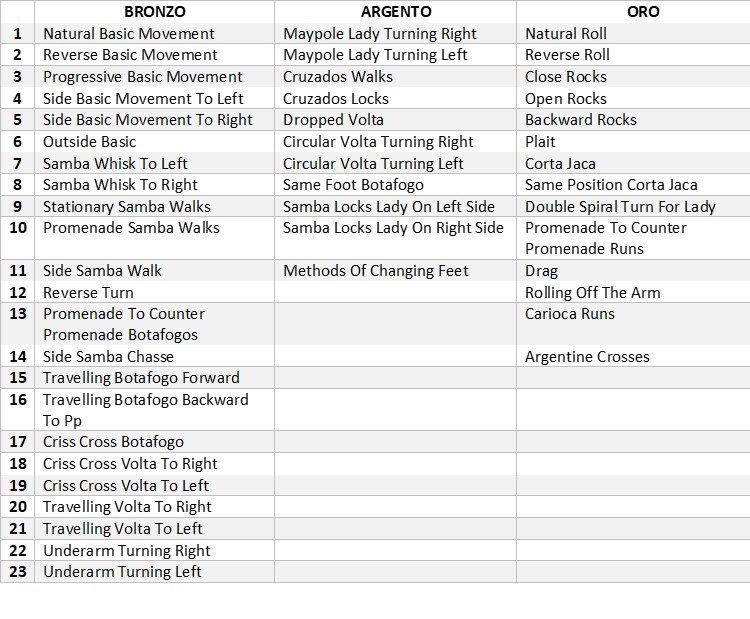
Cha-Cha-Cha

Rumba

Paso Doble
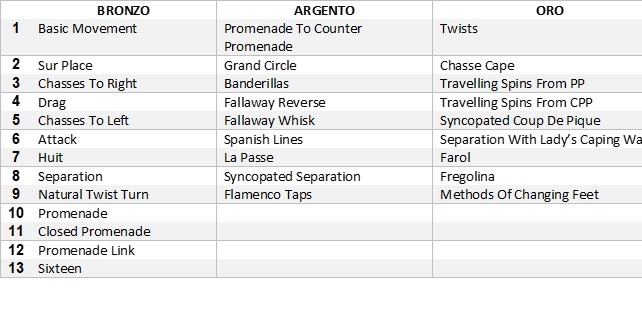
Jive
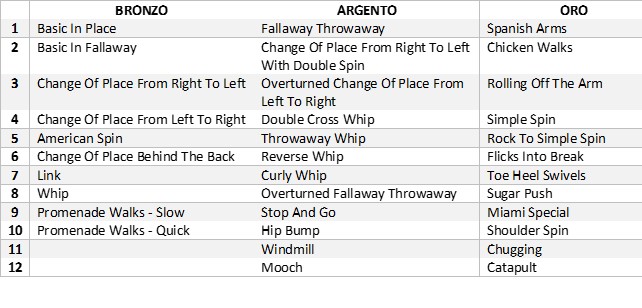
Waltz
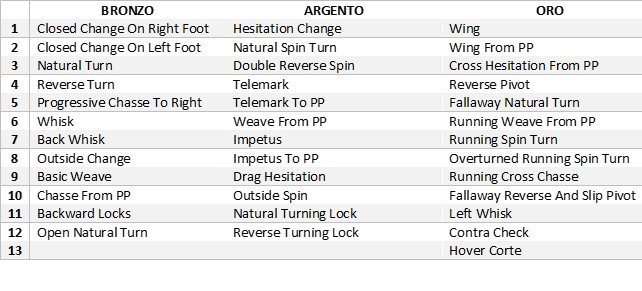
Tango

Viennese
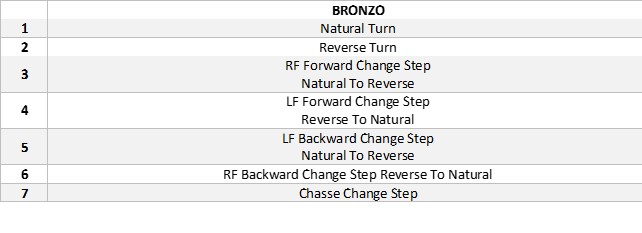
Slow Foxtrot
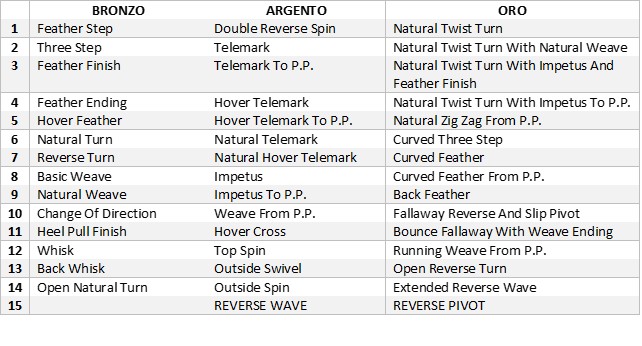
Quickstep
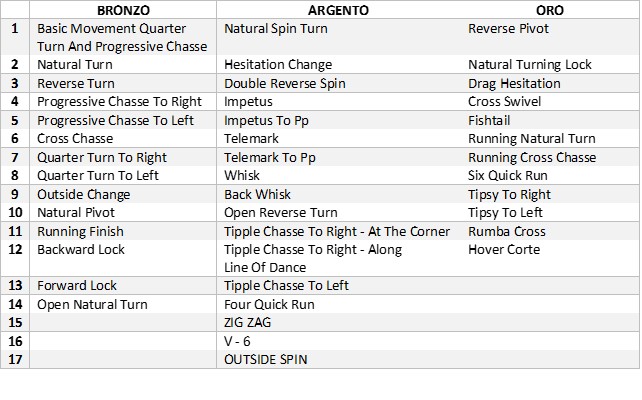
Rules and Guidelines (ENG)
Click on each title to expand the rule.
1. Competitions
1.1. Syllabus Cup - Syllabus Cups are for "Syllabus" level couples at the first levels of competition, with competition programmes/choreographies that contain exclusively basic steps.
1.2. Star Cup - Star Cups are competitions open to any level of couple, from beginners to International Class and Professional Couples.
1.3. Syllabus Championships - The Syllabus Championships is the season final of the Syllabus Cup and qualifies couples for upgrading for the next season.
1.4. Star Championships - The Star Championships is the end of the Star Cup season at which the winners of the Star Cup Ranking List are awarded.
1.5. International Championships - Universal Championships - The Italian Open - These are important international championships held each competition year.
1.6. CSIT World Amateur Dancesport Champiponships - Dancesport Heritage/IDSF organises on behalf of CSIT the World Championships open to all couples.
2. Participation
Participation at all of the competitions in Rule 1 is restricted to couples with one male and one female component.
3. Season
The season starts in April with the first Syllabus Cup and Star Cup and ends in march with the Syllabus Championship and Star Championship respectively.
4. Registration and Entry
To register in the competitions regolated by this document, every participant must register in the internet portal. The Category, Class, Entry and Ranking refers to the information contained in this portal. It is possibile that in the defferent federations, the same couple may achieve a different grade or category. In any case, the entries still refer to the category, class and ranking in the portal.
To enter any IDSF/Dancesport Heritage competition, entry and payment must be completed within the date indicated on the website homepage which will be 15 days before the first day of the competition. Late entries will be subject to a 10€ late fee per couple.
5. Category/Age Group Division
5.1. Definition - Age Groups, based on the year of birth of the athletes in a couple, can be defined by:
▪ a minimum and maximum age (e.g.: 10/11);
▪ just a minimum or just a maximum age (e.g.: Under 16, 35 and Over)
It is only possible to enter more than one Age Group, when the couple meets the criteria defined by the Age Group (e.g. a Couple whose age is 45 may dace in a 35 and Over as well as a 45 and Over event, but not in a 35/44 Senior 1 event).
5.2. Age Group Assignment and Duration - The Age Group is assigned at the beginning of the year (1st January), as per international regulations, and is based on the year of birth of the oldest member of the couple.
For the sole purpose of completing the season's ranking list, a couple may remain in their previous category until 31st March or until the Syllabus/Star Championships. For senior couples, the younger member of the couple must be not be more than five years
younger than the lower limit of the Age Group of the older partner. If this is not the case, the couple will dance in the lower age group until such time as the younger partner meets the minimum age requirement.
5.3. The Age Groups are:
| Age Group | Ages |
|---|---|
| Juvenile 1 | 06/09 |
| Juvenile 2 | 10/11 |
| Junior 1 | 12/13 |
| Junior 2 | 14/15 |
| Youth | 16/18 |
| Under 21 | 14/20 |
| Adult | 19/34 |
| Senior 1 | 35/44 |
| Senior 2 | 45/54 |
| Senior 3a | 55/60 |
| Senior 3b | 61/64 |
| Senior 4a | 65/69 |
| Senior 4b | 70/74 |
| Senior 5 | 75/O |
At the descretion of the Chairman, the Senior 1 and 2 Age Groups may be combined for Latin American competitions from D Class to B1 Class, as well as the Senior 3, 4 and 5 Groups.
The Under 21 Age Group is a sub-Category of the Adult age group and is only used to establish the particpants of Under 21 competitions or ranking lists..
6. Competition Classes/Grades
6.1. Definition - Classes divide athletes into sub-groups based on their level of preparation and are defined as follows:

6.2 Assignment and Duration - Upgrading can occur at any time at the request of the teacher of a couple at any time, whereas downgrading is not possible. When a new couple is formed, the couple assumes the higher class of the two, but a teacher may request downgrading by a maximum of one competition class in relation to the highest class of the two.
The PD Class (or "Professional Division") is a special class which represents the maximum expression in dancesport. Even though it is an Open Class in which any athlete may register, it is not possible to downgrade from PD barring exceptional circumstances. Athletes in the PD Class may be invited to judge athletes of lower classes.
6.3.Qualification for Upgrading
6.3.1. Syllabus World Championships: Couples classified in the top positions at the Syllabus World Championships can qualify for upgrading (which in this case becomes compulsory). The position necessary to be automatically upgraded depends on the number of competitors in the given category and class. When there are less than 6 competing couples in the competition, upgrading remains optional.
Couples qualifying for upgrading who belong to a lower grade will be upgraded by one competitive grade.
UPGRADING BASED ON POSITION OBTAINED AT THE SYLLABUS CHAMPIONSHIP
| Participating Couples | Position Required |
|---|---|
| 6 - 17 | 3 |
| 18 - 26 | 6 |
| 27 - 35 | 9 |
| 36 - 44 | 12 |
| 45 - 53 | 15 |
| 54 - 62 | 18 |
6.3.2. Ranking List Upgrading: At the end of the season, based on the Ranking List and the Ranking Rules (see Ranking List Rules), some couples will qualify for automatic upgrading. In this case the upgrading is compulsory and will be formulated according to the following table. If there are less than 6 couples in the Ranking List, upgrading will be at the discretion of the teacher/couple:
UPGRADING BASED ON RANKING 2020-2021
| Couples Ranked | Position Required |
|---|---|
| 6 - 11 | 3 |
| 12 - 17 | 6 |
| 18 - 23 | 9 |
| 24 - 29 | 12 |
| 30 - 35 | 15 |
| 36 - 41 | 18 |
| 42 - 47 | 21 |
| 48 + | 24 |
6.4. D Class - For D Class Upgrading, the ranking list takes into account all dances of the same style.
6.5. B1 Class - B1 couples will refer to the B Open ranking list for upgrading and couples reaching the required ranking will achieve upgrading to A Class..
6.6. Amateur A Open CompetitionsOpen A Class Competitions are reserved only for A1 and A2 class competitions.
6.6. Lower Grades in B Open Ranking -D, C, B3 e B2 Class couples will be required to upgrade by one grade based on the B Open ranking list if they have not qualified in the Ranking List of their own Grade.
6.7. Maximum Duration - A couple may not remain in classes C, B3 or B2 for more than 2 years.
6.8. Class Limitations and Open Classes - Participation in competitions for D, C, B3 and B2 class is limited to couples registered in those classes. B Open competitions are open to all D, C and B class competitors. Similarly A2 and A1 competitions are restricted to couples registered in those classes, whereas "Open A" events are Open to A2 and A1 Couples, and Open events are Open to all couples.
6.9. Dress Regulations - Dress, including hair, makeup and accessories must adhere to the requirements of the competition class. Full details of the requirements for each age group and class are in the "Dress Regulations" section.
7. Syllabus
7.1.1. The syllabus refers to the technique books pubblished by the WDSF.
7.1.2. Figures allowes
7.1.2.1. D e C Classes – All "Bronze Level" figures of each dance.
7.1.2.2. B3 e B2 Classes– All "Bronze Level" and "Silver Level" figures of each dance.
7.1.2.3. B1 Class – All "Bronze Level", "Silver Level" and "Gold Level" figures of each dance
7.1.2.4. Viennese Waltz – Only the "Bronze Level" figures of the Viennese Waltz may be used throughout the restricted syllabus classes.
7.1.3. Quantity of Turn, and all Yellow and Red columns are to be considered as suggestions rather than binding rules.
7.1.4. The Notes, General Principles and Specific Principles of all dances are to be considered as Bronze Level and can be danced at all levels of competition.
7.1.5. For D and C Classes, a maximum of three figures from Silver level may be used as connecting figures (es. a Silver figure may be used to connect two Bronze figures when necessary)
8. Ranking
The Ranking system compares couples over a number of competitions and allows couples to accumulate points for upgrading at the end of the competition season.
8.1 Points - Ranking Points can be obtained through participation at the Star Cup, Syllabus Cup, Star Championship, International Championship and Syllabus Championship competitions.
8.2.Formulation - Consult the dedicated ranking pages to see the latest version of the points system which is updated from year to year.
8.3. Final Ranking Calculation - The final ranking is calculated summing the three highest scores obtained at the Syllabus Cup competitions during the season, the three highest scores obtained at the Open B competitions at the Star Cups during the season, the particpation points from every competition danced and the points achieved at the Syllabus Championships.
9. Competition Running
9.1.Rounds and Finals
9.1.1. All phases of competition will use the International Skating System
9.1.2. The number of rounds will be formulated by the Chairman based on the entries received before the
close of entries.
9.1.3. Entries received after the closing date will only be considered if they do not influence the number of rounds in the competition timetable. If added entries affect the number of rounds required to run the competition, the Chairman will decide whether or not to accept the entries.
9.1.4. No less than half the competing couples will be chosen for the successive round of competition, until a final of 6 couples is reached (up to 10 in the case of late entries), except when more couples qualify through ties (e.g. if 13/24 couples qualify for the following round, 6 couples will still be selected for the final).
9.2. Judges
9.2.1. Judging panels will be composed of an uneven number of judges of no less than 5 judges..
9.2.2. Panels may be varied from one round to another at the discretion of the Chairman.
9.2.3. Selected judges must comunicate any incompatability to the chairman. A judge is to be considered incompatible if an athlete competing is directly related to them (direct family).
9.3. Syllabus Invigilator
9.3.1. In all competitions, one or more invigilators will be nominated by the Chairman and to check and monitor the figures performed during the competition. In case of incompatible figures, the Invigilator will propose appropriate measures to the Chairman, on whom rests the final decision. The Chairman may choose between::
9.3.1.1.Verbal Warning (rocommended course of action) – no direct consequences on the result of the competition;
9.3.1.2.Single dance disqualification– the couple is placed last in the dance in which the infringement occurred;
9.3.1.3. Event disqualification (only for excessive/repeated infringements) – the couple is placed last in the round in question..
9.4. Competition Dances
9.4.1. For D Class, single dance competitions in:
Latin American: Samba, Cha-Cha-Cha, Rumba, Jive
Standard: Waltz, Tango, Viennese Waltz, Quickstep;
Liscio: Mazurka, Polka, Foxtrot
9.4.2. For C Class, 3 dance events in: Standard: Waltz, Tango and Quickstep; Latin American: Samba, Cha-Cha-Cha and Jive; Liscio: Mazurka, Viennese Waltz and Polka; Ballo da Sala: Waltz, Tango and Foxtrot.
9.4.3. For B3 Class, 4 dance events in Standard: Waltz, Tango, Veinnese Waltz and Quickstep; Latin American: Samba, Cha-Cha-Cha, Rumba and Jive;.
9.4.4. In elimination round, less dances may be chosen at random by the Chairman..
9.4.5. The duration of each dance can vay based on the competition timetable and the decision of the Chairman but will have a minimm duration of (in minutes)::
D e C Class – 1:00
B3 e B2 Class – 1:10
B Open – 1:15
A, International e Professional – 1:20
9.4.6. Tempi- The tempo of each dance will respect the range denoted by the WDSF technique books..
Dress Rules (ENG)
The following tables refer to the full rules below. To consult the enter Dress Regulations section download the pdf, or to read online click Read Conents. Remember that it always possible "dress down" to follow the rules for the lower category or class.
Lady Standard
| Class | Juv 1+2 | Jun 1 | Jun 2 | 16/O |
|---|---|---|---|---|
| D | Dress Type S No Makeup Simple Hairstyle No Accessories |
Dress Type S Makeup Type B Simple Hairstyle No Accessories |
Dress Type S Makeup Type B Simple Hairstyle No Accessories |
Dress Type S Makeup Type B Hairstyle Open No Accessories |
| C/B3 | Dress Type S No Makeup Simple Hairstyle No Accessories |
Dress Type S Makeup Type B Simple Hairstyle No Accessories |
Dress Type S Makeup Type B Simple Hairstyle No Accessories |
Dress Type S Makeup Type B Hairstyle No Accessories |
| B2/B1 | Dress Type S No Makeup Simple Hairstyle Senza Accessori |
Dress Type S Makeup Type B Simple Hairstyle Senza Accessori |
Dress Type S Makeup Type B Simple Hairstyle Senza Accessori |
Dress Type T Trucco Open Hairstyle Senza Accessori |
| A | Dress Type A Makeup Type B Simple Hairstyle Senza Accessori |
Dress Type T Trucco Open Hairstyle Open Accessori Open |
Dress Type T Trucco Open Hairstyle Open Accessori Open |
|
| Int / Pro | Dress Type T Trucco Open Hairstyle Open Accessori Open |
Dress Type T Trucco Open Hairstyle Open Accessori Open |
Dress Type S
Simple momocolour dress with the same colour culottes, or a body and skirt of the same colour, or a black skirt with a white or black body or blouse.
Body
- Can be made from different types of material in the same colour.
- Transparencies using lace or mesh on top of the main dress may be used anywhere on the dress. Full transparencies may be used on the sleeves or in the upper part of the chest (above the bra-line).
- Small folds and pinch pleats may be used around the hips and buttons on the back of the dress as long as they are the same colour as the dress itself.
- Types of collars and sleeves allowed:

Skirt
- The skirt can be plain or pleated, from 1 to 3 half circles.
- The length can be from 5cm above the knee to the ankle.
- The skirt can have triangular inserts (transparent or lace) in the same colour as the skirt, starting from mid-thigh.
- Underskirts of the same colour are allowed.
- Nylon threading is allowed under the hem of the skirt, haircloth or satin finishing and frills are permitted on the skirt or underskirts.
- Any material of the same colour can be used, but metalic, fully transparent and skin colour are not allowed.
Shoes
- The shoes, which can be any colour, should be specific to the standard style.
- Shoes may be warn with short white socks or tan coloured socks or tights.
Dress Type T
Two piece dresses are not allowed. The design below indicates the mimnimum area to be covered:
▪ IA – Intimate Area: the parts of the body which must be covered by non-transparent non-tan-coloured material;
▪ PL – Panty Line;
▪ HL – Hip Line ;
▪ SA – Safety Area - the area which must be covered.
The dress should cover both knees, if the skirt has a split this should not be higher than the knee.
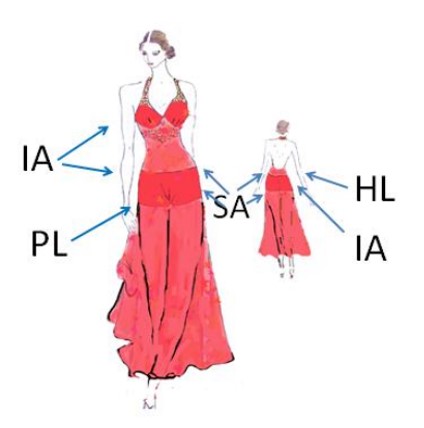
Dress Type U
As for Dress Type T but without any decorations or stones.
Makeup
No Makeup
Makeup is not allowed (foundation, lipstick, mascara, fake eyelashes, fake nails, artificial tanning cream, etc)
Makeup Type B
The lady can use light "day-to-day" makeup. Foundation, tanning powder on the face, lip gloss, lipstick and mascara are allowed.
Makeup Open
There is no restriction to Makeup.
Hairstyle
Simple Hairstyle
Hair may be held up in any style.
A flower the same colour as the dress may be warn.
Extensions, ornaments and stones are not allowed.
*for 12/13 A Class simple ornaments without stones and decorations are permitted.
Hairstyle Open
No restrainsts to hairstyles.
Accessories
No Accessories
Jewelry is not allowed (bracelets, rings, necklaces and similar). Simple stud earings and personal jewelry are allowed so long as they are not construed to be decorative and ornamental.
Accessories Open
All accessories are allowed
Religious and political symbols or symbols which are offensive to the public morale are not to be worn. Names of clubs or affiliations are also not permitted.
Lady Latin
| Classe | Juv 1+2 | Jun 1 | Jun 2 | 16/O |
|---|---|---|---|---|
| D | Dress Type L No Makeup Simple Hairstyle No Accessories |
Dress Type L Makeup Type B Simple Hairstyle No Accessories |
Dress Type L Makeup Type B Simple Hairstyle No Accessories |
Dress Type L Makeup Type B Hairstyle Open No Accessories |
| C/B3 | Dress Type L No Makeup Simple Hairstyle No Accessories |
Dress Type L Makeup Type B Simple Hairstyle No Accessories |
Dress Type L Makeup Type B Simple Hairstyle No Accessories |
Dress Type L Makeup Type B Hairstyle Open No Accessories |
| B2/B1 | Dress Type L No Makeup Simple Hairstyle No Accessories |
Dress Type L Makeup Type B Simple Hairstyle No Accessories |
Dress Type L Makeup Type B Simple Hairstyle No Accessories |
Dress Type K Trucco Open Hairstyle Open No Accessories |
| A | Dress Type J Makeup Type B Simple Hairstyle No Accessories |
Dress Type K Trucco Open Hairstyle Open Accessori Open |
Dress Type K Trucco Open Hairstyle Open Accessori Open |
|
| Int / Pro | Dress Type K Trucco Open Hairstyle Open Accessori Open |
Dress Type K Trucco Open Hairstyle Open Accessori Open |
Dress Type L
Simple momocolour dress with the same colour culottes, or a body and skirt of the same colour, or a black skirt with a white or black body or blouse.
Body
- Can be made from different types of material in the same colour.
- Transparencies using lace or mesh on top of the main dress may be used anywhere on the dress. Full transparencies may be used on the sleeves or in the upper part of the chest (above the bra-line).
- Small folds and pinch pleats may be used around the hips and buttons on the back of the dress as long as they are the same colour as the dress itself.
- Types of collars and sleeves allowed:

Skirt
- The skirt can be plain or pleated, from 1 to 3 half circles.
- The length can be from 5cm above the knee to 5cm below.
- The skirt may be cut unsymmetrically starting from mid-thigh at the highest point and the ankle at the lowest.
- The skirt can have triangular inserts (transparent or lace) in the same colour as the skirt, starting from mid-thigh.
- Underskirts of the same colour are allowed.
- Nylon threading is allowed under the hem of the skirt, haircloth or satin finishing and frills are permitted on the skirt or underskirts.
- Any material of the same colour can be used, but metalic, fully transparent and skin colour are not allowed.
Shoes
- Shoes of any colour, should be specific to the latin style.
- Shoes may be warn with short white socks or tan coloured socks or tights.
Dress Type K
A dress of any colour or multicoloured. The top may not me a bikini top but two piece dresses are permitted. The design below describes the minimum area to be covered:
▪ IA – Intimate Area: the parts of the body which must be covered by non-transparent non-tan-coloured material;
▪ PL – Panty Line;
▪ HL – Hip Line ;
▪ SA – Safety Area - the area which must be covered.
Fringe cannot be used alone as a skirt: the bottom part must have a skirt underneath the fringe. Also one piece catsuits are not permitted. The lower part may not just be a culotte.
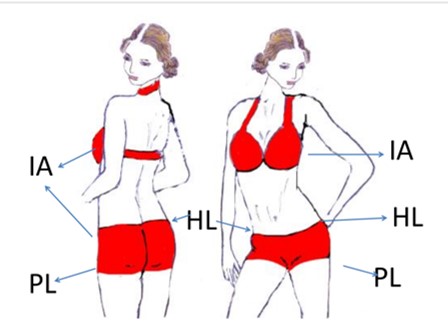
Dress Type J
As for Dress Type K but without any stones or accessories attached to the dress.
Makeup
No Makeup
Makeup is not allowed (foundation, lipstick, mascara, fake eyelashes, fake nails, artificial tanning cream, etc)
Makeup Type B
The lady can use light "day-to-day" makeup. Foundation, tanning powder on the face, lip gloss, lipstick and mascara are allowed.
Makeup Open
There is no restriction to Makeup.
Hairstyle
Simple Hairstyle
Hair may be held up in any style.
A flower the same colour as the dress may be warn.
Extensions, ornaments and stones are not allowed.
*for 12/13 A Class simple ornaments without stones and decorations are permitted.
Hairstyle Open
No restrainsts to hairstyles.
Accessori
No Accessories
Jewelry is not allowed (bracelets, rings, necklaces and similar). Simple stud earings and personal jewelry are allowed so long as they are not construed to be decorative and ornamental.
Accessories Open
All accessories are allowed
Religious and political symbols or symbols which are offensive to the public morale are not to be worn. Names of clubs or affiliations are also not permitted.
Uomo Standard
| Class | Juv 1+2 | Jun 1 | Jun 2 | 16/O |
|---|---|---|---|---|
| D | Dress Type C Makeup, Hairstyle & Accessories Type C |
Dress Type C Makeup, Hairstyle & Accessories Type C |
Dress Type C Makeup, Hairstyle & Accessories Type C |
Dress Type C Makeup, Hairstyle e Accessories Type D |
| C/B3 | Dress Type C Makeup, Hairstyle & Accessories Type C |
Dress Type C Makeup, Hairstyle & Accessories Type C |
Dress Type C Makeup, Hairstyle & Accessories Type C |
Dress Type C Makeup, Hairstyle & Accessories Type D |
| B2/B1 | Dress Type C Makeup, Hairstyle & Accessories Type C |
Dress Type C Makeup, Hairstyle & Accessories Type C |
Dress Type C Makeup, Hairstyle & Accessories Type C |
Dress Type D Makeup, Hairstyle & Accessories Type D |
| A | Dress Type C Makeup, Hairstyle & Accessories Type C |
Dress Type C Makeup, Hairstyle & Accessories Type C |
Dress Type D Makeup, Hairstyle & Accessories Type C |
Dress Type D Makeup, Hairstyle & Accessories Type D |
| Int / Pro | Dress Type D Makeup, Hairstyle & Accessories Type C |
Dress Type D Makeup, Hairstyle & Accessories Type D |
Dress Type C
- White or Black long-sleeved Shirt (in cotton or lycra) warn tucked into trousers. Rolled up sleeves are not permitted..
- Optional black waistcoat. Maximum length: under the glutes.
- Use of black tie or bowtie is compulsory.
- The trousers must be classi cut, black, with or without pleats.
Bands in black satin are allowed at waist level (max 5 cm) and on the outside seam line (max 2 cm). Shiny, metallic, elaborated, embroidered and transparent material is not allowed.
- Optional black belt with classic black or silver buckle, without labels or brands.
Shoes
- Shoes of any colour, should be specific to the standard style.
- Shoes may be warn with short white socks or tan coloured socks or tights.
Dress Type D
- Black or dark tailsuit, white shirt and white bowtie.
- Full dress suit: black dinner jacket with black trouser, with a white bowtie or black tie.
Makeup, Hairstyle e Accessories
Type C
- Makeup is not permitted.
- A short haircut is preferible. Long hair should be tied up in an orderly fashion.
- Visible jewelry is not permitted.
Type D
- No restrictions on maekup or jewelry.
- Religious and political symbols or symbols which are offensive to the public morale are not to be worn. Names of clubs or affiliations are also not permitted.
- Long hair should be tied up and presented in an orderly fashion.
Uomo Latin
| Classe | Juv 1+2 | Jun 1 | Jun 2 | 16/O |
|---|---|---|---|---|
| D | Dress Type M Makeup, Hairstyle and Accessories Type M |
Dress Type M Makeup, Hairstyle and Accessories Type M |
Dress Type M Makeup, Hairstyle and Accessories Type M |
Dress Type M Makeup, Hairstyle and Accessories Type N |
| C/B3 | Dress Type M Makeup, Hairstyle and Accessories Type M |
Dress Type M Makeup, Hairstyle and Accessories Type M |
Dress Type M Makeup, Hairstyle and Accessories Type M |
Dress Type M Makeup, Hairstyle and Accessories Type N |
| B2/B1 | Dress Type M Makeup, Hairstyle and Accessories Type M |
Dress Type M Makeup, Hairstyle and Accessories Type M |
Dress Type M Makeup, Hairstyle and Accessories Type M |
Dress Type N Makeup, Hairstyle and Accessories Type N |
| A | Dress Type M Makeup, Hairstyle and Accessories Type M |
Dress Type M+ Makeup, Hairstyle and Accessories Type M |
Dress Type N Makeup, Hairstyle and Accessories Type M |
Dress Type N Makeup, Hairstyle and Accessories Type N |
| Int / Pro | Dress Type N Makeup, Hairstyle and Accessories Type M |
Dress Type N Makeup, Hairstyle and Accessories Type N |
Dress Type M
- Choice between white or black long-sleeved shirt (in cotton or lycra) or a black or white polo-neck. The shirt must be warn tucked into trousers. Sleeves may not be rolled up.
- A black tie or bowtie must be warn with the shirt.
- Black, classic cut trousers with or without pleats.
Bands in satin are allowed at the waist (max 5cm) or on the outside seams of the trousers (max 2 cm). Shiny, mettalic, embroidered or otherwise elaborated material is not permitted.
- Optional black belt. The classic black or silver buckle must be free of labels or brands.
Shoes
- Shoes of any colour, should be specific to the latin style.
- Shoes may be warn with short white socks or tan coloured socks or tights.
Dress Type N
- Shirt or top of any colour with short or long sleeves, warn in or out of the trouser. Rolled up sleeves are not permitted. Open shirts must be warn closed to the navel.
- Trousers of any colour except tan..
- If a belt is warn, it must have a classic black or metal buckle without labels or brands.
Makeup, Hairstyle e Accessories
Type M
-È vietato il trucco.
- È preferibile il taglio corto di capelli. Se i capelli sono lunghi devono essere raccolti in una coda ordinata.
- Sono vietati i gioielli visibili.
Open
- Non ci sono restrizioni in riferimento a trucco e gioielli.
- È vietato l’uso di simboli con riferimenti religiosi, politici o offensivi della pubblica morale. Non sono ammessi nomi e loghi riferiti all’ASA di appartenenza.
- Se i capelli sono lunghi devono essere raccolti in una coda ordinata.
Syllabus (ENG)
Samba

Cha-Cha-Cha

Rumba

Paso Doble

Jive

Waltz

Tango

Viennese

Slow Foxtrot

Quickstep



